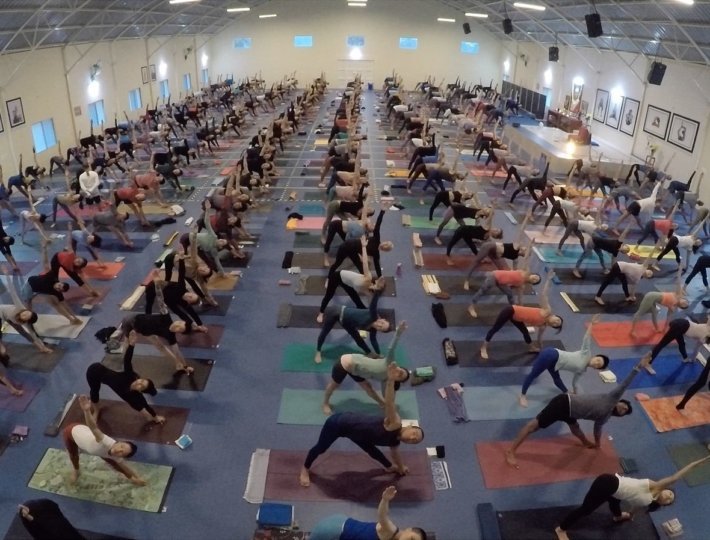You’ve got enough work in your life, and when exercise is just one more task competing for your precious time, it’s easy to lose motivation. So why not try a physical activity that’s actually fun to do?
Sports are great for this, but if you’re not the competitive (or coordinated) type, play-based workouts are an even simpler alternative. There’s plenty of science that says play is great for the brain activity of adults, but here’s the real reason to turn your workout into a play session: “We have to encourage and coax working out. You have to keep someone on the treadmill,” says David Jack, a strength and conditioning specialist in Phoenix, Arizona, and the founder of the ActivLab. “You have to be stopped from continuing to play.”
When an activity is fun, you may also work harder than you realize. “Most people usually smile at the end of exercise, but not during,” says Jeremy Frisch, owner and director of Achieve Performance Training in Clinton, Massachusetts. Frisch says those smiles help people forget about the work they’re doing and focus on the game. In a relay race, his clients might do six sprints of 60 yards each. “But if I said, ‘We’re going to do six 60-yard sprints,’ they’d look at me like I was crazy. With a race or game, you don’t think twice about statistics.”
Most importantly, if the exercise you’re doing is effective, easily accessible, and keeps you injury-free—and you have fun doing it—you’re more likely to stick and stay. And see lasting results. You don’t need a coach to tell you how to play—just follow these suggestions for active games you can do with kids, with other adults, and even by yourself.
With a Group: These Cups Make Fitness a Party
With just a pile of party cups (or cones or other plastic cups), Lance Breger, founder of Infinity Wellness Partners in Washington, DC, plays a simple game with both his children’s wellness and corporate wellness groups—and the adults who are playing can’t stop laughing.
“As adults, most of us are working really hard. We laugh 30 times per day, as opposed to 300 times per day as a kid,” says Breger. Games like this allow stress to melt away. “As soon as you start a game, it’s like everyone flashes back. Everything adult that’s caught in their mind is gone.”
What You Need:
• Stack of cones or plastic cups, at least three per person playing
• 1-1,000 people to play with
How to Play: Place the cups around a large, open area like a driveway, yard, or floor. Divide the players into two teams—one team of “tippers,” and one team to stand the cups back up. Set a timer for a short duration (about a minute), and send the teams off to play. When time expires, whichever team has more cups in “its” position wins. Then do it all again.
Fitness Benefits: When playing this game, you’re not just tipping cups or standing them up. You’re sprinting, changing directions, and moving laterally—a component that’s missing from many gym fitness programs and can help prevent injury. The short bursts of time turns the game into interval cardio—an alternating protocol of high intensity work and rest—that’s been proven to burn more fat than traditional, steady-state cardio. And each time you bend down, you’re squatting or lunging—two primary movement patterns that can strengthen your butt, quads, hamstrings, and core.
With a Friend: A New Way to Play with Cards
Like Frisch’s relay race, this fitness game from David Jack takes what would be a tortuous, traditional workout—isometric holds of squats and lunges—and distracts the player with a fun goal. And the distraction piles additional benefits onto each exercise that translate to the real world.
Moving this way “tests our competence with movement patterns. You don’t own a movement until something unexpected happens, and you can manage it,” he says. So when you lean to the right to catch a card while lunging, you test your balance and coordination, as well as your mastery of that lunge position. “You’re able to extend your bubble of effectiveness [in that movement] away from yourself in all directions. We want to not just have strength but to be able to use it. And this drill does that.”
Of course, you won’t notice. You’ll be playing the game.
What You Need:
• Deck of playing cards (or business cards or index cards)
• A partner
How to Play: Stand a few feet from each other, with one person holding the cards. Both players assume a split-squat position—to do this, take a large step forward with your right leg, descending as you step until your left knee almost touches the ground. At the bottom of the split squat, both of your knees form right angles, with your right knee above—but not in front of—your toe.
In this position, the player with the deck throws one card at a time in the area of the partner. The partner must catch cards while maintaining the lunge position, leaning left and right, reaching up and down. Try to catch five or 10 cards, then rest, switch legs—and switch the thrower/catching roles.
The game can be played with other exercises, too—try holding a squat position, stand on one foot with a knee raised, or assume a bird dog (or Warrior 3) position. For more high-intensity movement, Jack says to face each other and do shuffles left and right, trying to throw and catch while maintaining the same speed.
Fitness Benefits: Besides the burning benefits of isometric lunges and squats, leaning from side to side and reaching up and down adds a ton of core stability to each of these movements. Having to maintain these positions also means training your balance and preparing for unexpected shifts—which translates both to sport and life, says Jack. When you’re out for a run and an unexpected divot or bump pops up in the grass, you will be better equipped to maintain your balance and avoid injury due to this game.
With a Kid (or Two): Turn a sheet into a full-body workout
As part of her fitness education programs for kids, Yvonne Kusters, founder of Let’s Play Today, an educational fitness program for kids based in Philadelphia, suggests parents create an exercise “treasure box” in the house—kids and adults fill it with scraps of paper, each with an activity written on it. Once per day, each child chooses one scrap, and the family gets active together.
“It makes it more random, so it’s not like, ‘I don’t want to do that,’” says Kusters. “It’s, ‘Let’s do the treasure chest game! We’ll do what the paper says.’ It becomes part of the family culture.”
One suggestion she gives for treasure chests with young children is a game with a sheet—it takes the old elementary school gym class game of using a parachute to create ripples and brings it down to house-size. (Oh, and it’ll tire you out, too.)
What You Need:
• A sheet
• 1 to 3 kids
• Some open space
How to Play: Spread the sheet out and have each kid (and adult) grab it with two hands. Work together to make waves in the sheet—start with small waves, then do large ones. Do one-handed waves, two-handed, and alternate.
To mix it up further, have one kid release her hands. Raise your arms way overhead to make the sheet act like a parachute, and see if one of the children can run under the sheet from one side to the other before it reaches the floor.
After all this, turn the sheet into a “sled.” Have the children sit on one side while you drag them on the sheet—try pulling with just your arms, or walk forwards or backwards while pulling. Have them do the same with you (or another child) on the sheet.
Fitness Benefits: The rippling of the sheet mimics the rope training popular for interval cardio in gyms—this pumping action is like sprinting for your arms. And the sled dragging is just like doing sled training in the gym: It’s powerful functional training for the legs, core, arms, and butt.
Make a Bet with Friends: Go Back to School with an Obstacle Race
Some friends may be up for any fitness game, but others might take some convincing. To get friends (or reluctant teens) to join in a race with you, Breger suggests creating stakes. Set up a race or competition where the winner gets to pick a dinner location—and the losers have to pay.
Once the bet’s set, set up an obstacle race in the backyard, Frisch suggests. Work together with lawn chairs, balls, and tables and include jumping, crawling, running, and throwing elements.
“Of course, we squat and lunge and pushup and row, but there’s time for races and play, too,” Frisch says of ending adult sessions with such races. “Anything you can do to change the monotony of exercise can be good.”
What You Need:
• Space
• Obstacles like chairs, tables, and balls
• A watch (for timing)
How to Play: Really, however you want. Choose a timed race or relay with multiple teams.
Fitness Benefits: Besides high-intensity work plus sprinting and start-stop motions, crawling patterns can have great strength benefits—and wear you out quickly.
The crab walk, for instance, is great for the butt and core and is a pattern Frisch uses with many clients. To make it harder with this variation, you can add to your race: In the top of the crab position, reach one arm forward while maintaining a flat body position, then return the hand to the ground. Repeat this with each arm and leg.
When You’re Alone: Grab a Balloon and Get Laughing (and Fit)
For fitness fun alone, every expert seems to recommend dancing—closing the door, rocking out to your favorite five songs, and getting funky when no one’s looking.
“Go where you go. Ten minutes later … that was amazing,” Jack says. “And you got 10 incredible minutes of free play fitness.”
But for those who are even embarrassed to boogie by their lonesome, Breger suggests grabbing a balloon. The balloon can do what Jack’s cards did in the partner game—make regular movements more challenging for your core and balance by adding unpredictable changes.
What You Need:
• A balloon
How to Play: Breger suggests starting a few feet from the wall with your feet firmly planted. Bounce the balloon against the wall and catch it again and again, keeping your feet planted.
Once you’ve got that, try the same wall dribble in various positions—on one foot, while holding a squat, or holding a lunge.
To incorporate more movement, perform a crab walk, reaching a hand or leg up to keep the balloon airborne as you move across the room.
Fitness Benefits: As with Jack’s card partner game, each shift in the traditional movement pattern you choose—squat, lunge, crab walk—forces your core to stabilize your body, meaning you’re adding abs work onto the benefits you already get from each exercise.












Comments (0)